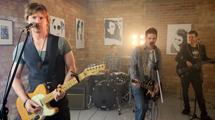
Call us today on 07449 539 492
Product Review – Canon C100 & Carl Zeiss Prime Kit
C100 & ZEISS LENS – CORPORATE VIDEO PRODUCT REVIEW
Since Jet Productions was formed in 2012 almost all of our corporate videography has been completed using canon DLSR’s with Canon lenses. These cameras gave us the flexibility to change lenses; a huge plus in being able to tell stories in a richer, more powerful way. Overall I have found that camera’s like the 550D, 600D, 7D and 5D Mark ii produce great image quality, are relatively cheap, easily maneuverable and with the right cable can record sound meaning that an entire film can be created using just the one camera.
Recently though, with the need for corporate video rising and myself wanting Jet to stand out among the crowd I was looking for equipment that can increase the quality of our productions. The biggest problem that small – medium video production companies face is a way of creating films that mimic the quality of a Hollywood feature, but by using equipment that is worth a fraction of what some films have to spend.
Through this search I have come across some varied cameras including Canon C100, C300, 1DC, 1DX & 5D Mark ii along with many lenses by makers such as Tokina, Samyang & Zeiss. In this blog I wanted to give an overview of my findings using the C100 and a range of Carl Zeiss lenses for corporate video, as hopefully this may help you in the decision of which kit to use for your next project.
OVERALL FINDINGS
C100
– Although slightly heavier, was still as portable as DSLR’s.
– It worked fine on the cheaper jib arm and slider that I have, although with the heavier Zeiss lenses was right on the edge of being too heavy. Therefore with any added extras (matte box, roll bars, viewfinders etc) it would either not fit or be too heavy for medium sized jib arm/ sliders.
– The general use of the camera (Menu/ white balance/ shutter speed/ ND filters etc) is more like a normal video camera, but all were easy to control.
– The viewfinder being able to flip out meant it was slightly easier to see the screen from many angles, although it doesn’t tilt downwards.
– One major problem with the DLSR’s is the capacity to ‘crush’ the image. This camera gave a great overall softness to the image that is more in tune with the likes of RED. I am hugely happy with the increase in image quality between the 5D mark ii and the C100.
– Another problem faced with DLSR’s is the noise being found in the mid tones of the image. Overall this problem was still there as you can visibly see noise within mid tones, but it is minimal in comparison to the 5D mark ii or lesser 7D.
– It is a cropped sensor, therefore you have to be aware of this before shooting and make your lens choices appropriately.
– You could not do a slower frame rate than 25fps, but with corporate video this is not much of an issue.
– Capturing is again more like a video camera. Rather than copying straight across I had to capture the footage through Final Cut Pro 7, which in the process converts the video files together into .mov files within your capture scratch folder. This process does however take up a lot more space. In comparison for us a normal corporate days shoot on a 5D Mark ii comes to about 50GB, and when using the C100 (After captured) it came to around 175GB!
– Overall it was easy to use manually, with settings that can easily be changed throughout a shoot and gave a great image quality.
CARL ZEISS LENSES
Lenses Used – 15mm, 35mm, 50mm, 85mm 100mm and 135mm.
– Overall the quality of these lenses were easily parallel to Canon’s EF lenses, if not superior. Great considering their relatively low price!
– The build quality is high, although fairly heavy, they are simple to use, especially when manually focusing and exposing (Which is what we always do).
– The long focus ring that had been put on was a great addition as it allows much more precision on focus pulls.
– There was what seemed to be an added ‘crispness’ to the image, while keeping quality within the bokeh.
– Each individual lens has it’s unique qualities, but overall they performed better than I expected and I would use them again over other lenses within the £600 – £2000 price range.
One of our customers, Jay Staniland of NHS Newark & Sherwood commented;
“I would definitely recommend using the C100 & Carl Zeiss lenses; I was able to tell a difference from previous films we have commissioned, the images were clearer and more defined. This is better purely for aesthetic reasons.”
The biggest learning curve for me was that with any increase in the quality of equipment, there are always added costs, however small and these costs need to be added to the project. The big choice that needs to be made is if your client will appreciate the added cost and if it really is worth it to them, as dependent on the subject matter, the output and the audience it may not be worth it. Although as filmmakers we are constantly striving to better our films and use the best tools to do so, sometimes we have to make tough decisions in order to create a product that completes all of our clients needs while being within their budget.
Overall from the past few projects using this camera and lenses I would highly recommend them for another other professional filmmakers on a fairly tight budget. Used correctly with other filmmaking tools they can bring your production to a broadcast quality.
This entry was posted on Tuesday, June 3rd, 2014 at 2:55 pm and is filed under News.


